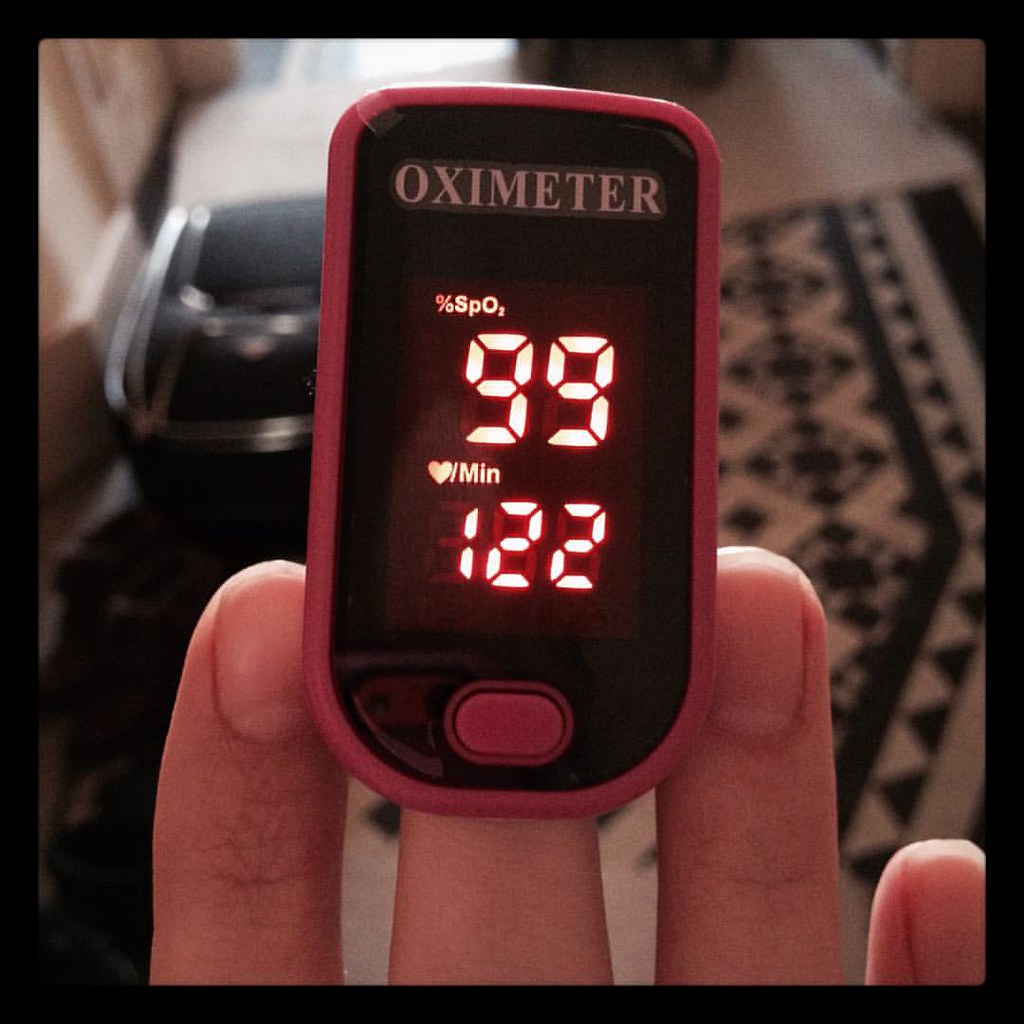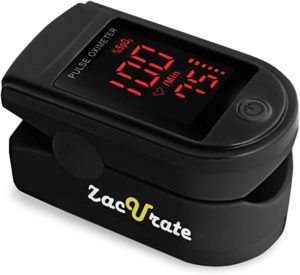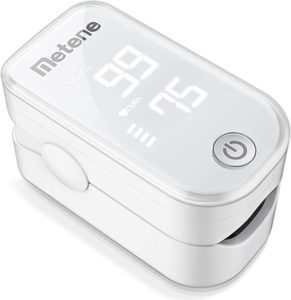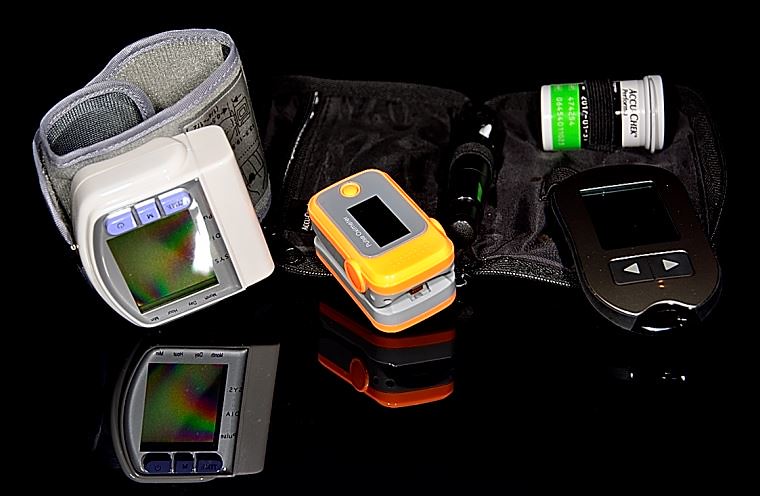Best finger pulse oximeter for home (Reviews & Buying Guide)

One of the answers to COVID-19 is probably at your fingertip, doctors say. With the growing experience of dealing with sick people who report to hospitals with breathlessness, experts have recommended the use of a relatively cheap device at home that can forewarn you about any impending crisis – the pulse oximeter. In this article, we have captured the guide on how to choose and buy the Best finger pulse oximeter for home
The small device, which fits into the palm of your hand, measures the oxygen saturation in the blood in a non-invasive manner. All one needs to do is clip the device onto a finger tip, and it will show the SpO2 level (peripheral oxygen saturation), or the oxygen level in the blood. Its role in COVID-19 patients’ health monitoring is significant.
Pulse oximeters provide a real-time reading of someone’s blood oxygen levels, heart rate, and blood pressure, and can assist in determining their current wellbeing.
Page Contents
Why finger pulse oximeters are important right now?
The spread of COVID-19 has urged the need for home pulse oximeters to help track potential symptoms. Coronavirus majorly attacks the cardiovascular system, it’s not uncommon for anyone infected to experience shortness of breath or have trouble breathing. With a pulse oximeter, it’s possible to monitor someone’s condition closely and to know when their oxygenation levels may start to get dangerously low. The device allows someone who’s self-isolating to get a better sense of these conditions and whether it’s time to see a doctor.
“7 Best finger pulse oximeter”
1. Newnik PX701 Fingertip Pulse Oximeter


Product is designed to provide an affordable yet accurate way for spot-checking blood oxygen saturation levels and pulse rate. All you need is a few seconds and you can check these levels anytime, anywhere. Now measuring your pulse rate and oxygen levels in the body becomes easy. All you need is a few seconds and you can check these levels anytime, anywhere. Product is certified from FDA, CE. Its reliable, accurate with 1 year warranty.
Pros
- Pre-set buzzer alarm & blinking function for low/high readings
- 4 rotating views on water-resistant 2 color OLED screen
- Equipped with the latest plethysmograph waveform technology
- Meets international quality standards (CE & FDA)
- Auto on/off feature, low battery indicator
- Suitable for both kids & adults
- Available in 2 colors
- 1 year warranty
Cons
- Alarm sound not very loud
- Suitable for spot reading only (not continuous reading)
2. Dr Trust (USA) Professional Series Finger Tip Pulse Oximeter


Dr Trust USA Professional Series Pulse Oximeters is USFDA and CE approved. The newly upgraded Dr Trust Finger Pulse Oximeter is an affordable and accurate way to check pulse rates and blood oxygen saturation levels. Simple button press design allows for easy operation. Small portable size makes it easy to handle and carry. It is helpful for athletes, mountain climber and pilots to obtain quick and accurate oxygen saturation readings, anytime, anywhere. The product is water resistant and comes with audio visual alarm. It is one of the best pulse oximeters available in the market for medical professionals.
The water resistant nature of the device makes it ideal for not just clumsy and normal individuals, but also for swimmers and other athletes too.
The perfusion index (the ability to measure even the slightest of the pulses) of this device is 0.2 where as any other device would typically be 0.6. This makes it the best device to measure not just the SpO2 levels, but also the pulse too.
This could also measure the respiratory rate of a human being. I.e, it cas measure the rate at which a person breathes and this number could be judged to understand how healthy a person’s lungs are.
Pros
- Can measure SpO2 levels, pulse and respiratory index
- Large and clear display
- Anti-Motion Free operation
- Battery level indicator
- IP22 makes the device water-resistant
- One button operation
- US FDA and CE approved
- 1 year manufacturer’s warranty for the product
Cons
- Could add a little clearly understandable user manual
- Could be a little more durable
3. CHOICEMMED Finger Pulse Oximeter


Fingertip Pulse Oximeter C1F is designed for spot-checking blood oxygen saturation levels and pulse rate. Using it, athletes, pilots, and people who would like to know their SpO2 and pulse rate can get accurate readings quickly. The operation of this oximeter is simple and convenient. You just need to plug one of your fingers into the comfortable clamp and press the button on the front panel Its small size makes it easy to carry around in its durable carrying case. Simple operation allows it to turn on and off with the touch of a button. This is not a medical device, perfect for sports and aviation.
Pros
- Our pulse monitor is easy to use and has an efficient One Button Operation. Our SPO2 Sensor will spot check and display in real-time SpO2, PR, Pulse bar graph which great for checking your pulse signal strength
- This spo2 pulse oximeter is not only durable but will have readings that are reliable and accurate. Comes with a battery-low indicator. 30+ hour run time.
- Our oxygen saturation finger monitor can be used as a pediatric pulse oximeter for kids and children as well as a blood oxygen monitor for adults
- This device is for Sports and Aviation use only and not intended for medical use. It’s great for mountain climbers, bikers, trainers, aviators, and general sports enthusiasts to spot check SpO2 on the fly
Cons
- Not waterproof
- No respiratory index
4. Zacurate Pro Series 500DL Fingertip Pulse Oximeter


Reliable and accurate to within 2%, the Zacurate Pro Series 500DL is latex-free and hypoallergenic with an average battery life of 40 hours. Recommended for adults and those over the age of 12, the Zacurate Pro Series 500DL comes in three colors and a large forward-facing LED display makes seeing your oxygen saturation, pulse rate and pulse strength in as fast as 10 seconds.
The Zacurate Pro Series 500DL fingertip pulse oximeter is manufactured according to the CE and FDA standards set for pulse oximeter. The pulse oximeter LED display now faces the user so that the user can read it easily.Taking a reading is easy, just clip it on to your finger and turn it on at the press of a button. The large LED display makes viewing the results A snap. Its small size makes it easy to carry around and a lanyard is also included for added convenience. Comes with 2 AAA batteries and a silicon cover to protect your pulse oximeter from dirt and damage
Pros
- Accurately determine your SpO2 (blood oxygen saturation levels), pulse rate and pulse strength in 10 seconds and display it conveniently on a large digital LED display.
- The ONLY LED pulse oximeter that can read and display up to 100% for SpO2.
- For sports enthusiasts like mountain climbers, skiers, bikers or anyone interested in measuring their SpO2 and pulse rate. SpO2 and Pulse Rate now faces instead of away from the user for an easy read.
- Finger chamber with SMART Spring System. Works for ages 12 and above.
Cons
- If finger is not warm it does not give accurate result.
- Its is slow
- Not Medicaly Recommended
5. Santamedical Fingertip Pulse Oximeter


This device provides quick and precise way to check pulse rates and blood oxygen saturation levels. Self-adjusting finger clamp plus simple one-button design allows for easy operation. Small portable size makes it easy to handle and carry. Helpful for athletes and pilots to obtain quick and precise oxygen saturation readings.
Features include an easy to read bright digital OLED display, 30+ hours of continuous monitoring on one set of batteries. Integrated SpO2 probe and processing display module plus SpO2 and Pulse Rate and bar. Low battery level indicator. Auto power off. Low power consumption on 2 AAA batteries. Comes with a hanging neck/wrist strap for use on the move. Intended use for spot check of pulse rates and blood oxygen saturation level at home, in sport and recreational use, such as mountain climbing, high-altitude activities and running.
Accurate in its operation, the display of this device is OLED lit with a bright backlight and is multi-directional in nature. The measurement of Pulse rate and SpO2 can be viewed as a pulse wave or a bar graph. This visually appealing representation of data increases the readability and ergonomics of the device.
A great inclusion to track your oxygen saturation levels and heart pulse tracking during outdoor sporting, flying on a plane, sports and other recreational adventurous stuff, these devices are not recommended for any medical use.
Pros
- Approved by FDA
- Can measure both Pulse Rate and O2 Saturation levels.
- Can display the data in either bar graph or pulse wave formats
- 2 coloured OLED Display which is rotatable
- Automatic power off after 10 seconds of inactivity
- Can run for 30+ hours on a single set of 2 batteries
- Includes a neck lanyard and a carry pouch
- 1 year manufacturer’s warranty
Cons
- Not medically recommended
- Does not have a respiratory index
- Could improve a little on the design provided the device is for recreational and sporting purposes.
6. MiBest OLED Finger Pulse Oximeter


The Fingertip Pulse Oximeter designed to provide an easy and accurate way for spot-checking your blood oxygen saturation levels and pulse rate. Whether you’re a pilot, an athlete and want frequent oxygen saturation monitoring, this oximeter is the perfect choice for on-the-go readings that fit with your lifestyle, with simple operation that allows it to turn on with the touch of a button, and a small size coupled with a soft carrying case makes it a great travel companion that can be taken anywhere. This oximeter is designed for sports and aviation use, and is not intended to diagnose any medical condition or to be used in medical applications.
Pros
- Its pulse monitor is easy to use and has an efficient One Button Operation. Our SPO2 Sensor will spot check and display in real-time SpO2, PR, Pulse bar graph which great for checking your pulse signal strength.
- Its accurate dual-color oximeter displays SpO2 in 4 directions, 4 display modes, and 10 levels of adjustable brightness. Comes with a battery-low indicator
- Its oxygen saturation finger monitor can be used as a pediatric pulse oximeter for kids and children as well as a blood oxygen monitor for adults
- NOTE: This device is for Sports and Aviation use only and not intended for medical use. It’s great for mountain climbers, bikers, trainers, aviators, and general sports enthusiasts to spot check SpO2 on the fly.
- Comes with a 12-month warranty
Cons
- Its is little slow
- Not Recommended for medical use
7. Metene Pulse Oximeter Fingertip


The Metene Portable Oximeter is perhaps the most aesthetically pleasing, sleekest-looking pulse oximeters on the market.
Operating the Metene Portable Oximeter is a breeze. Users clamp the tiny device to their fingertip and press a single button. Within thirteen seconds, the results are brightly displayed. The soft silicon film on the inside of the machine keeps users comfy while the oximeter generates a reading.
Besides its modern look, the thing that makes the Metene Portable Oximeter stand apart is its outstanding accuracy. Not only can it register results of 100% SpO2, but its accuracy is also comparable to that of a hospital-grade oximeter.
Also, users that find any manufacturing flaws or reading inconsistencies have a full year after the purchase of the oximeter to return and report these failings.
Pros
- Using the most advanced MCU chip and sensor, blood oxygen signal is collected by photoelectric sensing principle. Only need several seconds to get measurement results,
- High quality transparent acrylic panel. The oxygen meter body is elaborately made of ABS material, very exquisite and compact. One button operation and shut down automatically without operation in 8 seconds. Large LED and backlight display make it very easy to read.
- Metene fingertip pulse meter very light and easy to carry.This spo2 monitor is attached with detachable lanyard convenient to measure your oxygen saturation anywhere.
Cons
- It takes a full thirteen seconds to display results, which is slightly longer than comparable oximeters.
How do Pulse Oximeter Devices work?
The device is first clipped on fingers, toes or earlobes, which are quite transparent in our body.
Then, probe side of it emits a light, containing two unique wavelengths (650nm and 805nm) and the other side contains a light sensor. The haemoglobin in our blood and oxygen molecules that aren’t certain of being attached to them absorbs light.
The sensors can discriminate about how many cells of haemoglobin in the blood is passing through artery to the attached oximeter and how many of cells oxygen molecules is attached which is called “SpO2” or peripheral capillary oxygen saturation.
Also Read:
- Top 5 Best Humidifier
- Top 10 best piano for kids
- Top 5 Best Hoverboard Price
- 9 Must avoid activities that cause miscarriage
- Best Forehead thermometers in India
Buying Guide

FDA Certified
Pulse oximeter is a class II device and FDA registration is required before selling in US. You can verify the certification by going to the FDA Medical Device Data Base and enter the manufacturer name in the search field to find out for sure.
Accuracy and reliability
The primary purpose of a pulse oximeter is to measure your oxygen saturation (SpO2) and pulse rate. So the key selection criterion is to find one that produce accurate results within its operating range consistently and reliability. Pulse oximeters generally use similar mechanisms for reading data and differ in how they are manufactured.
If you need an accurate reading, you should validate your pulse oximeter by comparing it with others, such as those in your doctor’s office or medical clinics. Most oximeters can take a reading within a few seconds and have an accuracy of ±3%.
The accuracy is often affected by motion. If your hand trembles, find a model that is more tolerant to hand movements or hold your hand still while taking readings.
Ease of use
Fingertip pulse oximeters operate by inserting your finger into the sensor and then pressing one button. They are easy to operate. Make sure the display is large enough for you to read. Some can display the data in different ways making them easier to read.
Sensor size
Make sure you can insert your finger comfortably in the sensor. This is normally not an issue for clip-on type. For children and persons with small hands, consider a pediatric pulse oximeter.
Other features :
There are other features, non-essential, but will assist you in using the oximeter:
- Memory: Save previous readings and timestamps; generate various statistics.
- Multi-person memory: Save readings for more than one person.
- Computer interface: Save readings to a computer for further analysis by you or your doctor.
- Software program: Analyze the data.
- Appearance
- Ease of storage
- Accessories: storage case, log book, battery
Which finger is best for pulse oximeter?
In a survey of health care workers for monitoring pulse oximetry, index finger was selected by 80 % for SpO2 measurement (Mizukoshi et al. 2009). Index finger dominantly is fed from deep palmar arcus created from radial artery, but a study of 37 volunteers found that the highest reading came from the third finger on the dominant hand. A close second was the dominant thumb. So if you are right-handed, use the right middle finger. If you are left-handed, use the left middle finger. The difference between fingers is small, so if you prefer the index finger, that’s fine.
What is the normal range for a pulse oximetry reading?
If you do have a pulse oximeter and are checking your oxygen levels, it’s important to know that a level between 95 and 97% is considered normal by the American Lung Association; anything below that would be a reason to call a doctor, and anything under 90% would be a reason to go to the emergency room.

Should I monitor my oxygen levels at home?
It’s possible that a home monitor could give a faulty reading or be used incorrectly, prompting a patient to seek care unnecessarily. If you or someone in your home shows a very low reading, you may want to test your device on a healthy person to confirm that it is working correctly and discuss it with your doctor.
Can I Use this Pulse Oximeter on My Child?
Yes. However, It depends on the finger size, if it reaches to sensor then we can use pulse oximeter. Sometime finger chamber of the Pulse Oximeter may be too big for a person with small fingers. This can affect the accuracy of the reading
Do long nails or nail polish make a difference?
Yes. Dark nail polish can affect the accuracy of the reading. Long nails would make it difficult to insert your finger properly in the clip which can lead to inaccurate results.
Can these pulse oximeters be used overnight?
No. These pulse oximeters are all single-use items, meaning they can’t be used for continuous monitoring around the clock.
How can I get the best reading from my pulse oximeter?
There is a list of variables below that needs to be avoided to get the best reading:
- Do not move during testing, body movement including shivering, sneezing can affect the right reading.
- Use an earlobe when your nails are painted as painted fingers and toenails can affect proper readings.
- Take reading in rooms with normal or low light, as the bright sun light or overhead light can affect reading.
- When exposed to water the sensitive electron components inside the oximeter break. For cleaning, purpose use damp cloth or alcohol swab.
Conclusion
Out of all the oximeter, we would like to suggest Santamedical Fingertip Pulse Oximeter as best oxygen saturation monitor which is accurate in its operation, the display of this device is OLED lit with a bright backlight and is multi-directional in nature. The measurement of Pulse rate and SpO2 can be viewed as a pulse wave or a bar graph. This visually appealing representation of data increases the readability and ergonomics of the device